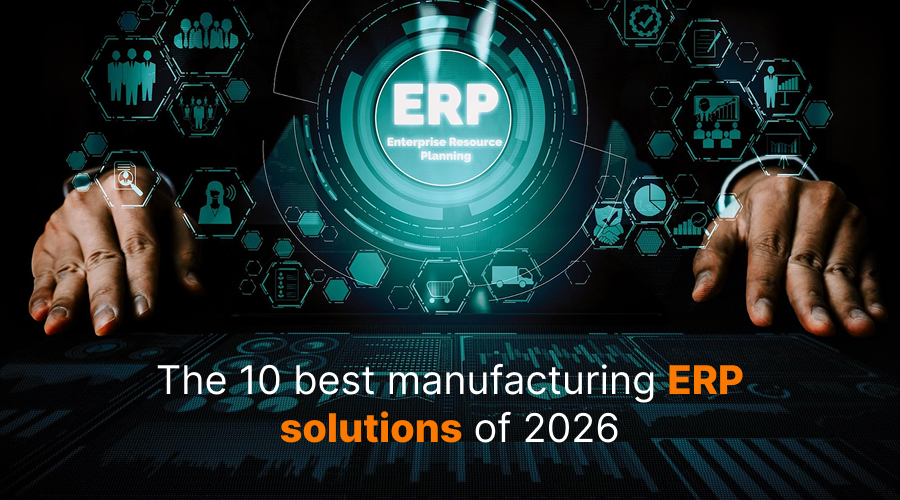
This blog explains how ERP solutions for manufacturing reshape production by unifying planning, data flow, supply chain visibility, and shop floor control. It shows how manufacturers use an ERP system for manufacturing to reduce waste, speed up decision making, and scale operations with modern manufacturing management software.
Entering into 2026, manufacturers are heading to the new year with more volatility and more data than any previous decade. This has led to even tighter margins than ever before. ERP (Enterprise Resource Planning) is the system that basically controls all the vital decisions that are made both on the shop floor as well as in the boardroom. Contemporary production settings make use of ERP systems, which are instrumental in streamlining the company processes, consolidating the data, making the supply chains more efficient and giving the necessary back up to the real-time production intelligence. A decade ago, ERP was a back-office tool. Today? It runs the entire business.
We bring you the top 10 manufacturing ERP systems heading into 2026 by examining their real-world capabilities and explaining how each system aligns with different types of manufacturers. Once you have gone through the possibilities, you will definitely see a simple, doable summary of the features that really make a difference in your operations and let you pick the right ERP solution for your needs. This is all the information you need.
The 10 Best Manufacturing ERP Solutions of 2026

Industries require ERP software that are rapidly evolving, can be easily integrated, and bring operational value that can be measured. All the systems in this list support the core workflows, but each platform differs in its approach to adaptability to industry-specific demands.
Below is the detailed breakdown of the ten systems shaping modern manufacturing.
1. NetSuite ERP
NetSuite opened the door for small and mid-sized manufacturers to adopt full ERP without huge hardware investments. It delivers scalable cloud ERP with a strong financial core, mobile ERP access, and multi-entity support. Manufacturers pick NetSUite because it replaces fragmented accounting tools like QuickBooks with an integrated platform.
NetSuite offers strong inventory controls, real-time analytics, supply chain visibility, and global reach, remaining as one of the most accessible and cost-effective first-ERP options for manufacturers entering structured digital transformation.
2. Epicor Kinetic
With decades of industrial experience, Epicor Kinetic makes for a great choice for discrete manufacturers in complex production environments. This is primarily due to its support for engineering-heavy workflows, multi-stage production, quality management, global finance, and compliance features. Plus, Epicor Kinetic also comes with a modern interface that makes managing advanced operations a breeze.
Kinetic suits manufacturers running between $10 million and $100 million in annual revenue who need predictable performance, strong configuration options, and a platform designed around industrial realities.
3. Infor CloudSuite Industrial (Syteline)
Infor’s CloudSuite Industrial offers deep mixed-mode capabilities and fits mid-size and large enterprises with complex manufacturing lifecycles. The platform comes with built-in support for cloud and on-premise deployments, advanced protection planning, integrated quality, IoT-driven performance enhancements, and low-code extensibility.
Its architecture makes it super easy for manufacturers to handle multi-site operations, global compliance, and custom production workflows. It stands out among large-scale enterprise manufacturers that need flexibility without losing process integrity.
4. SAP S/4HANA
SAP’s S/4HANA system blends decades of enterprise ERP expertise with next-gen AI, analytics, and real-time data processing. Built on the HANA in-memory platform, it helps manufacturers respond instantly to demand changes, supply chain shifts, and production constraints.
Large global manufacturers rely on SAP/4HANA for multi-entity operations, global finance compliance, enterprise process automation, and tight integrations with the SAP ecosystem. Mid-market manufacturers also adopt it when they need long-term scalability and proven global architectures.
5. Cetec ERP
Cetec gets you a fully web-native ERP with one of the lowest price points in the manufacturing ERP market. Its modules cover CRM, quoting, production, warehousing, and quality, yet it costs a fraction of traditional ERP systems. Small and mid-sized manufacturers love Cetec because it removes the financial and technical barriers normally associated with ERP adoption.
The system’s cloud-native structure is what allows for super fast deployment and easy scalability, making it a strong entry-level ERP with surprisingly robust capabilities.
6. Acumatica Cloud ERP
Acumatica uses a consumption-based licensing model that removes per-user limits. It gets you flexible deployment (private, public, or hybrid cloud ), strong industry add-ons, and a modern interface. Acumatica fits mid-sized discrete manufacturers that are looking for IoT-friendly modules and rapid scalability.
Its technology-first engineering team builds new capabilities faster than almost any competitor, making it a really solid option for manufacturers planning a digital-forward strategy.
7. Microsoft Dynamics 365 Business Central
Business Central unifies the best of Microsoft’s historical manufacturing ERP tools like AX, NAV, and GP into an all-cloud system. It integrates seamlessly with Microsoft 365, Power Platform, Azure, and Teams, making it a strong fit for organisations that already rely on Microsoft products.
Manufacturers adopt D365 BC for predictable pricing, fast implementations, real-time data visibility, and a scalable architecture that supports both small teams and enterprise operations.
8. Sage X3 ERP
Sage X3 is your perfect balance of performance, modularity, and global capabilities. It handles both process and discrete manufacturing, supports multi-company and multi-country environments, and comes with a strong financial and supply chain backbone. The workflow in Sage X3 adapts quite easily to organisations that manage complex batch processes or multi-site operations.
Growing mid-market manufacturers adopt Sage X2 when they want ERP depth without committing to large-enterprise cost structures.
9. DELMIAWorks (IQMS)
DELMIAWorks stands out because it does a brilliant job of unifying ERP and MES (manufacturing execution systems) into a single manufacturing-first platform. Its real-time shop floor visibility, tight process manufacturing controls, and integrated production intelligence make it ideal for manufacturers who want an MES-grade system combined with ERP capabilities.
By removing the need to integrate external MES systems, DELMIAWorks reduces much of the complexity and delivers highly accurate data. All this while lowering the long-term costs for businesses.
10. IFS Cloud
IFS Cloud combines ERP with EAM (Enterprise Asset Management) and ESM (Enterprise Service Management), giving manufacturers cross-functional control in one system. Enterprises with revenue above $75 million use IFS to manage complex global manufacturing operations and detailed supply chain requirements.
IFS provides one of the strongest industry-specific architectures in the market, supporting aerospace, industrial manufacturing, heavy equipment, and global production models.
Core Benefits of Manufacturing ERP

Manufacturers adopt ERP for measurable gains across every function:
➢ Automation at scale
ERP automates most of the routine tasks like data entry, compliance documentation, inventory and purchase updates and more. With automation entering the scene, businesses see a reduction in labour strain and an increased accuracy.
➢ Unified data
A manufacturing ERP centralises all operational data in one place. This gives teams real-time visibility into materials, financials, production status and a whole lot of other useful information.
➢ Analytics and intelligence
Modern ERP systems analyse operational signals in real time and allow manufacturers to get insights into performance issues, forecast demand, schedule machines efficiently, and minimise downtime.
➢ Supply chain strengthening
ERP streamlines procurement, warehousing, logistics, and vendor management to keep supply chain risks under control
➢ Compliance management
ERP tracks audit trails, quality controls, regulatory data, and documentation across different industries.
➢ Modular growth
Manufacturers expand ERP systems through add-on modules and integrations to support robotics, predictive maintenance, Internet of Things (IoT), and plant automation.
➢ AI and machine learning

AI identifies supply chain risks, predicts equipment failures, improves production accuracy, and pinpoints optimisation opportunities for businesses.
How to Choose the Right Manufacturing ERP for your Business
Manufacturers selecting ERP will need to approach the process with clear, grounded expectations. These guidelines are essential to streamline the decision-making process.
- Identify your operational model: Discrete, process, or mixed-mode manufacturing requires different ERP strengths.
- Analyse your production complexity: High-variance manufacturing needs robust configuration and BOM structures.
- Determine your scale: User counts, multi-site requirements, global operations, and regulatory environments influence system choice.
- Evaluate deployment style: Cloud-first is now the norm, but some manufacturers still need hybrid or on-premise models.
- Assess integration needs: If you run advanced robotics, IoT, or MES, ensure your ERP solution is able to accommodate it.
- Plan long-term: ERP should support your next decade of growth, not only current workflows.
Final thoughts
Contemporary manufacturing requires ERP systems that can bring about flexibility, precision, and business insight. Leading systems accommodate different categories of manufacturers. However, they all have one common, straightforward objective. Enhance efficiency and increase profit by integrating operations. Choosing the right ERP will determine how resilient your manufacturing organisation becomes in an unpredictable decade.






